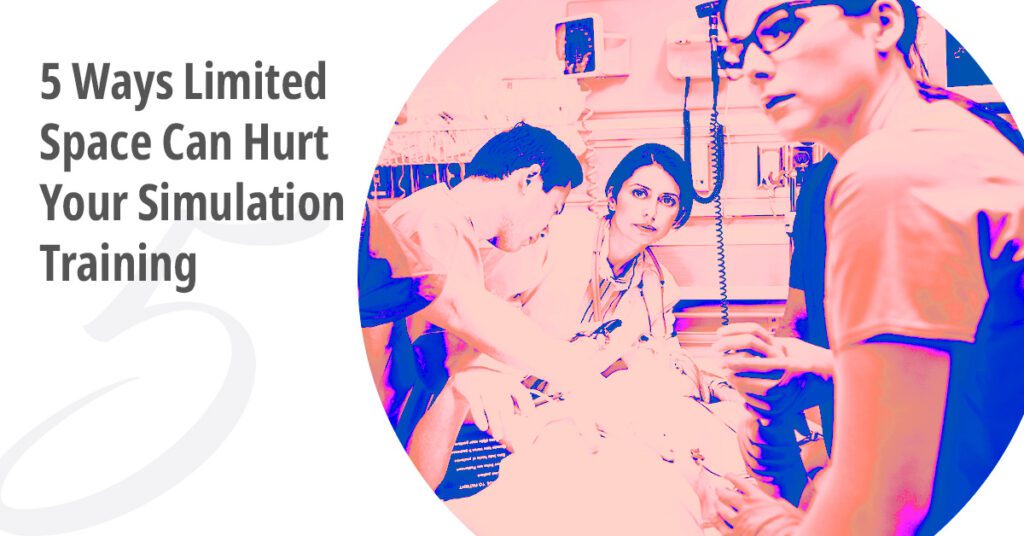In a perfect world, every healthcare educator would have access to a dedicated simulation center filled with the latest simulation technology. Such simulation centers would provide an ideal environment for immersive, realistic training, allowing educators to replicate real-world scenarios accurately and comprehensively. However, the reality for many healthcare programs is quite different. Budget constraints and limited space often force program administrators to conduct healthcare simulation training in less-than-ideal settings.
These constraints pose significant challenges, impacting the quality and delivery of educational programs. Limited space can reduce the realism of simulations, increase distractions, limit the availability of essential equipment, reduce participant capacity, and introduce safety concerns.
In this article, we will highlight five key ways that limited space can hurt your simulation training and provide practical tips to help you make the most of the spaces you have, regardless of your budget.
1. Inconsistent Learning Environments
2. Less Realistic Environment Creation
A training space devoted to simulation allows healthcare educators to more effectively create a realistic and immersive environment that resembles actual clinical settings. Full-scale replicas of hospital rooms, including patient beds, IV stands, medical gas supplies, and advanced manikins that exhibit lifelike symptoms and responses such as breathing, blinking, vocalizations, and heartbeats, all contribute to enhanced realism.High-fidelity, realistic scenarios in healthcare simulation training improve clinical skills, critical thinking, and decision-making. Without dedicated spaces, instructors struggle to create such environments consistently, impacting the overall quality of simulation-based medical education.
3. Lack of Scheduled Programming Capabilities
Without a dedicated training space, and its accompanying simulation management systems, healthcare education programs may struggle with the scheduling and automation of regular simulation sessions. Efficient scheduling capabilities allow educators to organize and manage scenarios, meetings, and resource bookings. Additionally, this type of system generally supports the coordination of multiple simulation rooms, equipment, and participant schedules, reducing the potential for conflicts or double bookings.
Furthermore, more robust simulation solutions that you’ll find in dedicated training spaces often have automation features that allow administrators to send out reminders and notifications to participants, or program entire simulation sessions to minimize the involvement of staff, allowing them to focus on observation.
4. Reduced Assessment and Feedback
Simulation-based education relies heavily on the observation and assessment of student performance. Dedicated training space should ideally include areas for instructors to monitor simulations and provide immediate, constructive feedback—something that is not always possible. Lacking a dedicated space for debriefs can significantly impede the effectiveness of this assessment process.
Without a private, quiet area for reflection and discussion, the quality of feedback may be compromised. Participants may feel inhibited in expressing uncertainties or mistakes freely due to concerns over privacy or interruptions, curtailing the open communication essential for effective learning and improvement in healthcare simulation training.
5. No Inventory Management
Simulation healthcare educators require plenty of space to store and manage equipment and supplies such as manikins, hospital beds, and medication carts. With a lack of room devoted specifically to materials needed to conduct simulations, there’s a risk of damage or loss of equipment, leading to additional costs and potential disruptions in the learning process.
Given these challenges, it’s clear that having a training space entirely devoted to simulation technology can significantly enhance healthcare education programs. Dedicated spaces support consistency, realism, efficient use of time and resources, and student reflection—all of which are vital for preparing competent and confident practitioners.
Fortunately, for healthcare educators with budget or space limitations, there are flexible mobile simulation platform that can help them achieve their educational goals without being tied to a physical location. Education Management Solutions, a leading simulation software company, offers Training in Motion, a portable simulation platform that allows healthcare simulation professionals to conduct simulation training anywhere anywhere it’s needed with lightning-fast deployment and tremendous ease-of-use.
Contact an EMS solutions expert today to discuss how Training in Motion can overcome your space limitations and enhance your simulation-based learning!

